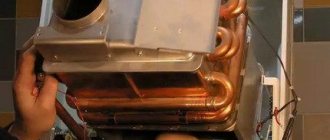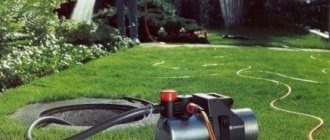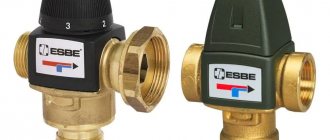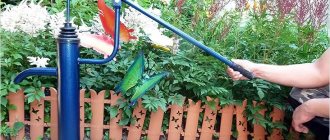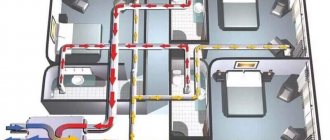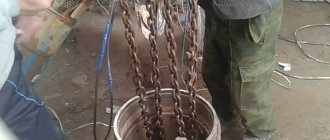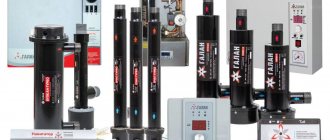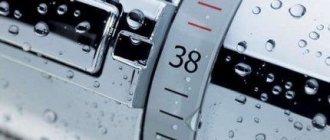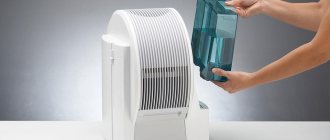The submersible well pumps presented for sale are reliable, durable and durable household equipment. Thanks to the specific design of the stainless steel body, they work efficiently in conditions of constant dampness and provide a stable supply of water resources to consumers.
Reputable and respected manufacturers, well-established in the market, provide a company guarantee for their products and provide maintenance and repair of special equipment in certified service centers. Among the variety of offers, sometimes it’s difficult to make the right choice, don’t you agree?
We offer the TOP 15 best models of pumps of different mechanisms of action with a description of their operating parameters and an assessment of strengths and weaknesses. The following selection tips will help you decide on the appropriate option for organizing water supply for a private home, cottage, watering your garden and vegetable beds.
Types of well pumps
Pumping equipment is divided into two main types:
- Submersible;
- Superficial.
They differ primarily in location. Surface ones are located in the well caisson or directly in the house, submersible ones are placed in the well casing pipe, in the body of water. They also have design differences - except for the main type, centrifugal pumps.
There are other types of mechanisms - manual piston, membrane, pumping stations and so on. In appearance, submersible pumps have the shape of a cylinder, while surface pumps have a pump body with an air-cooled electric motor.
Features of manual equipment
A hand pump allows you to pump liquid from a well located on the site to the sampling point with little effort. The water flow rate here is much lower than in automatic devices. But manually pumping a bucket of water is not difficult - even a teenager can cope with this task.
However, lever mechanisms have a number of significant advantages.
Key positions include:
- autonomy - the device can be used where there is no electrical network, or the cost of electricity is too high, and connecting powerful equipment is not economically profitable;
- low material acquisition costs - a manual unit costs much less than an automatic one and there is not always a real need to pay a significant amount of money for equipment that will not be used constantly;
- versatility - hand pumps on the market are presented in a wide range; you can choose a suitable device for both deep and shallow wells;
- maintainability - if any components of lever models fail, they are very easily and quickly replaced;
- simple installation - installation does not require specialized knowledge and is carried out without the use of specific, expensive tools:
- elementary use - for the pump to start supplying water, you only need to raise and lower the handle several times; even a child, woman or pensioner can easily cope with this task.
The equipment has only two disadvantages. The first is the physical effort required to obtain liquid for drinking or irrigation. In this regard, automatic pumps that pump water out of a well without direct human intervention win.
An aesthetically attractive pump with a lever mechanism can be not only a practical and convenient device for supplying water, but also an original decoration for a summer cottage
The second is low productivity compared to automatic units.
However, this cannot be considered a full-fledged disadvantage. After all, such models are intended for installation in places where there is no need for constantly flowing water from the tap or an uninterrupted supply is simply physically impossible to organize.
Hand pumps with plastic housing are only suitable for summer use. Cast iron and metal units operate normally year-round. Need insulation under conditions of sudden changes in temperature conditions
Typically, hand pumps are used in summer cottages, visited only in the summer, and in places where there are problems with a constant supply of electricity.
Manual models are also used as an accompanying water supply option. So, it will be quite difficult to provide the required amount of water to vegetable beds every day. A hand pump will help you cope with this task, and without extra costs for electricity.
Borehole submersible water pumps
Submersible pumps are installed in the aquifer of the well shaft (suspended on a cable). Their body is made of materials that are not subject to the negative effects of corrosion - stainless steel, high-strength plastic. The pumps are water-cooled; a protective mesh is installed on the suction to prevent large particles from entering.
Advanced models have high-quality automatic safety systems - dry-running protection and overheating protection. Built-in fine filters and a check valve are also installed. The power cable is laid together with the water supply pipeline during the construction phase.
Based on their design and principle of operation, the following types of submersible pumps are distinguished:
- Centrifugal;
- Vibration (pulse);
- Screw;
- Vortex.
Submersible pumps are characterized by a very high pressure indicator - more than 100 meters of water column (more than 10 kgf/cm2). This indicator has made them the main type of equipment for water sources more than 9 - 10 meters deep. Submersible pumps are characterized by their absence of noise and unpretentiousness, but monitoring their operation is difficult due to their remote location.
Downhole submersible centrifugal pumps
Centrifugal pumps are the most popular model. The principle of their operation is based on the use of centrifugal forces. The pump housing contains an impeller with vanes (curved blades). Water is sucked into the central part of the housing, the wheel rotates and gives the water a direction of movement from the center to the wall of the housing. This creates some excess pressure.
There is a discharge pipe on the body - through it, water leaves the pump at operating pressure. For high values of water pressure (pressure), several housings are installed in series, the pressure increases in stages. Units with high pressure can have a body height of up to 2 meters.
Working elements - wheels, seals, etc. - are made of stainless materials.
Submersible vibration pumps for wells
Vibration pumps operate on the principle of membrane impulse. An electric coil supplies a mechanical impulse to the piston, and the piston transmits force to the membrane. The membrane bends and a portion of water is sucked into the diaphragm.
Then the piston reverses, and the suction valve closes, the membrane displaces water into the discharge pipe. The operating mode has a high frequency and cyclicity - due to this, a constant flow of water occurs.
Vibration pumps create a pressure of up to 20 meters of water column, their service life is limited only by the life of the membrane. The disadvantage of this type of equipment is that in the absence of a large gap to the casing and soil, vibration constantly raises the suspension of particles. This gradually destroys the well and clogs the water.
Submersible screw pumps for wells
The screw pump is designed on the principle of a “meat grinder without a knife.” A rotating screw (auger) is located in the stator with guide channels. It accelerates the sucked volume of water and directs it with pressure to the exit from the housing. Pumps of this type are capable of creating a pressure of up to 60 meters of water column (6 kgf/cm2).
Vortex pumps for wells
A rather rare type for use is a vortex pump. The impeller of the unit has a special optimized configuration - this gives the flow a turbulent component of movement.
Vortex pumps produce very high pressure, but have a short service life. This is due to the high mechanical load on the impeller and the increased speed.
Advantages of devices: which one to choose?
| Kinds | Advantages |
| Submersible |
|
| Superficial |
|
Surface pumps for water wells
The second type of well pumps is surface pumps. They are located near the wellhead (in a caisson) or in a private house. Water is sucked through a submersible hose (sleeve, pipe) placed in the aquifer of the well.
Most surface pumps are centrifugal type units. The electric motors are cooled by a fan built into the casing. The dimensions of the pumps are such that it is impossible to place several subsequent discharge chambers - therefore the pumps are limited in suction depth to 10 meters.
Manual surface pumps
The hand pump is the simplest member of the family. Using a manual drive lever, a translational movement is applied to the piston in the working chamber equipped with a valve system. Alternating opening of the valves ensures the supply of water at the outlet of the pump column.
The described unit is a rarity and is used very rarely - during a temporary lack of electricity.
Surface self-priming centrifugal pumps
Self-priming pumps are equipped with a check valve at the outlet; the working chamber must be constantly filled with water. The operation of the device is based on the centrifugal principle. The device has simple controls, without automatic protection.
Pumps of this type create a pressure of up to 10 meters and are designed for filling containers, watering, etc. The disadvantage is manual control, high noise level, lack of interlocks and automatic protection.
Surface pumping stations for water
The pumping station is an optimized self-priming pump. It is equipped on the basis of a hydraulic accumulator and has a built-in check valve. The station is equipped with a pressure monitoring system in the system as a whole. According to the sensor readings, the pump turns on (when the pressure drops below the set value) and turns off (when the set pressure is reached).
Stations are the main type of surface equipment for wells; they create pressure up to 10 - 12 meters. The disadvantage of operation is the increased noise level, so it is advantageous to place the station in a caisson.
Ejector and injection pumping stations
Pumps of this type are special pumping station configurations. They are equipped with small diameter pipes laid externally (ejector) or internally (injector).
Water in small-diameter bypasses moves at a higher speed, and at the exit from the ejector (injector) it accelerates the main flow of water.
Popular models
Many manufacturers of well pumps have long established themselves in the market. Their products have good consumer reviews. Such companies must provide a warranty card, according to which you can carry out free repair of equipment or exchange it within a specified time.
Among the best pump manufacturers there are both Russian and foreign companies.
| Submersible pump brand | Water supply L/h | Power, W | Water pressure m | Pump diameter mm |
| "Aquarius" | 1800 | 400 | 27 | 100 |
| "Typhoon" | 5000 | 100 | 65 | 102 |
| "Aguario ASP" | 1000 | 460 | 40 | 102 |
| "Water cannon" | 3300 | 460 | 35 | 98 |
| "Belamos SP" | 2000 | 800 | 90 | 96 |
| "Cascade" | 2700 | 250 | 42 | 75 |
| "Aguario ASP 3" | 4000 | 1100 | 90 | 85 |
| "Flux" | 6000 | 800 | 43 | 88 |
| "Flow" | 1500 | 370 | 35 | — |
| "Vodomet PROF" | 3300 | 460 | 35 | 98 |
Each type of well pump has its own advantages and disadvantages. In this regard, when choosing suitable equipment, it is necessary to determine exactly for what purposes the device will be used, comparing all the necessary technical characteristics.
Did the article help you?
Andrey
Ask questions
Ask questions and write answers in the comments
Selecting a well pump
The choice of pump for a well is made according to a set of indicators. There are scientific calculation methods, but a larger calculation can also be carried out.
The main indicators in the operation of the selected pump are:
- Pressure (pressure created), m of water column;
- Productivity, m3/hour.
The pressure characteristic consists of several components of the sum:
- The height (depth) of the well to the zero level of entry into the building;
- Resistance of the horizontal section of pipelines;
- Height to the upper water point;
- Minimum pressure in the home network;
- Power reserve – from 5 to 10%.
Moreover, the calculation should be carried out without taking into account the presence of a hydraulic accumulator at the station. It is designed to reduce the start-up frequency and smooth out pulsations. It is recommended to purchase and install a separate hydraulic accumulator of larger volume. The use of this device is mandatory for any type of pumping equipment.
Let's consider a special case - the well has a depth of 20 meters, the horizontal section is 8 meters long, the upper point of water intake (mixer) is located at a height of 2 meters. The minimum pressure for operating household equipment (washing machine, dishwasher, etc.) is from 1 to 1.5 kgf/cm2 (according to the product data sheet), that is, from 10 to 15 meters of water column.
The resistance of the horizontal section will be 8 x 0.3 = 2.4 meters. The final pressure is:
(20 + 2.4 + 2 + 15) x 1.1 = 43.34 meters (where 1.1 is the power reserve correction factor).
Next, the second value is determined - productivity. It is determined by the average water consumption per person per day - 200 liters. For a family of 4 people, the required volume of water will be 0.8 m3/day.
The constant period of water consumption is approximately 12 hours. The required pump capacity will be 800 l / 12 hours = 66.7 = 70 liters per hour. To account for peak loads, a correction factor of 1.25 should be applied. Then the final value will be 70 x 1.25 = 87.5 = 90 liters per hour (2.16 m3/day).
The calculated productivity value should not exceed the daily water limit of the well. Excess may cause clogging of the well and damage to the channels at its base.
The last stage of pump selection is selection according to the flow-pressure diagram. This diagram is present in the passport of each pump. Along the axes of pressure and flow (productivity) we mark the calculated values.
The intersection of points on the curve of the diagram will be real indicators of the operation of the unit under design conditions. The intersection point should be located in the middle part (middle third) of the graph.
Choosing a pump for a well is an important undertaking. Knowledge of the types of equipment and calculation methods allows you to select the necessary pump for a well without difficulty. You can involve specialists in the store in selecting a pump - as a rule, experienced managers know the selection methodology. At the same time, you can check your calculations - trust, but verify.
( , 1 today)
Feasibility of application
Hand pumps for pumping water do not require electrical power or the use of any other energy carrier, which is one of their most significant advantages. Manual water pumps can be used as backup equipment and used in cases where the main electrical device is unable to function due to a breakdown or lack of voltage in the power supply.
An advisable solution is to install a hand pump in summer cottages that the owners rarely visit, only from time to time.
In such cases, it is undesirable to use more expensive electric pumping equipment, which requires regular maintenance and more thorough care. In addition, an electric pump left unattended by its owners for a long time can simply be stolen.
Hand pumps for water are actively used in dachas and country houses that do not yet have a central power supply. In such cases, the use of a manual device for pumping liquids will allow you to obtain the required amount of water both for domestic needs and for watering garden and vegetable plants in the summer.
Advantages and disadvantages
A manual pump, as mentioned above, can be used as a backup or main equipment for pumping water from underground sources located on the territory of summer cottages and household plots. Before deciding to use this particular pumping equipment, you should become familiar with the nuances of its operation, and also take into account its advantages and disadvantages.
If we compare manual water pumps with electric ones, we can highlight the following advantages of using the former:
- very affordable price;
- simple design, which provides such equipment with reliability, durability, ease of maintenance and repair;
- complete autonomy;
- ease of installation;
- presence of minimum requirements for the installation site.
The design of the manual water pump allows you to make it yourself without any problems
To use a hand pump, you do not need any special knowledge or skills in handling equipment; if the need arises, you can repair such a device yourself, without involving specialists for this purpose. It will not be particularly difficult to make a manual water pump with your own hands, and the characteristics of the homemade device will differ slightly from the technical parameters of serial models.
It is worth considering the disadvantages that manual pumping equipment has.
- This device is less comfortable to use than an electric pump: physical effort is required to activate it.
- Pumping water from an underground source when using manual pumping equipment cannot be organized in a continuous mode.
